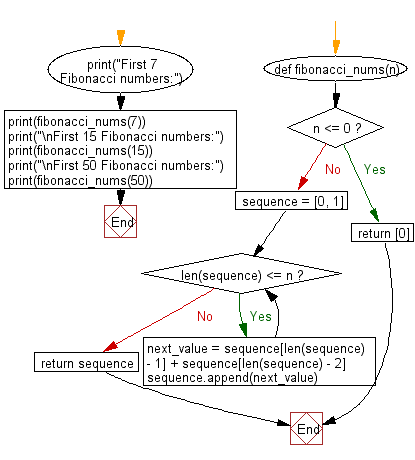Python: Generate a list, containing the Fibonacci sequence, up until the nth term
Python List: Exercise - 265 with Solution
Write a Python program to generate a list, containing the Fibonacci sequence, up until the nth term.
- Starting with 0 and 1, use list.append() to add the sum of the last two numbers of the list to the end of the list, until the length of the list reaches n.
- If n is less or equal to 0, return a list containing 0.
Sample Solution:
Python Code:
def fibonacci_nums(n):
if n <= 0:
return [0]
sequence = [0, 1]
while len(sequence) <= n:
next_value = sequence[len(sequence) - 1] + sequence[len(sequence) - 2]
sequence.append(next_value)
return sequence
print("First 7 Fibonacci numbers:")
print(fibonacci_nums(7))
print("\nFirst 15 Fibonacci numbers:")
print(fibonacci_nums(15))
print("\nFirst 50 Fibonacci numbers:")
print(fibonacci_nums(50))
Sample Output:
First 7 Fibonacci numbers: [0, 1, 1, 2, 3, 5, 8, 13] First 15 Fibonacci numbers: [0, 1, 1, 2, 3, 5, 8, 13, 21, 34, 55, 89, 144, 233, 377, 610] First 50 Fibonacci numbers: [0, 1, 1, 2, 3, 5, 8, 13, 21, 34, 55, 89, 144, 233, 377, 610, 987, 1597, 2584, 4181, 6765, 10946, 17711, 28657, 46368, 75025, 121393, 196418, 317811, 514229, 832040, 1346269, 2178309, 3524578, 5702887, 9227465, 14930352, 24157817, 39088169, 63245986, 102334155, 165580141, 267914296, 433494437, 701408733, 1134903170, 1836311903, 2971215073, 4807526976, 7778742049, 12586269025]
Flowchart:

Visualize Python code execution:
The following tool visualize what the computer is doing step-by-step as it executes the said program:
Python Code Editor:
Have another way to solve this solution? Contribute your code (and comments) through Disqus.
Previous: Write a Python program to create a two-dimensional list from given list of lists.
Next: Write a Python program to cast the provided value as a list if it's not one.
What is the difficulty level of this exercise?
Test your Programming skills with w3resource's quiz.
Python: Tips of the Day
Find current directory and file's directory:
To get the full path to the directory a Python file is contained in, write this in that file:
import os dir_path = os.path.dirname(os.path.realpath(__file__))
(Note that the incantation above won't work if you've already used os.chdir() to change your current working directory, since the value of the __file__ constant is relative to the current working directory and is not changed by an os.chdir() call.)
To get the current working directory use
import os cwd = os.getcwd()
Documentation references for the modules, constants and functions used above:
- The os and os.path modules.
- The __file__ constant
- os.path.realpath(path) (returns "the canonical path of the specified filename, eliminating any symbolic links encountered in the path")
- os.path.dirname(path) (returns "the directory name of pathname path")
- os.getcwd() (returns "a string representing the current working directory")
- os.chdir(path) ("change the current working directory to path")
Ref: https://bit.ly/3fy0R6m
- New Content published on w3resource:
- HTML-CSS Practical: Exercises, Practice, Solution
- Java Regular Expression: Exercises, Practice, Solution
- Scala Programming Exercises, Practice, Solution
- Python Itertools exercises
- Python Numpy exercises
- Python GeoPy Package exercises
- Python Pandas exercises
- Python nltk exercises
- Python BeautifulSoup exercises
- Form Template
- Composer - PHP Package Manager
- PHPUnit - PHP Testing
- Laravel - PHP Framework
- Angular - JavaScript Framework
- Vue - JavaScript Framework
- Jest - JavaScript Testing Framework
